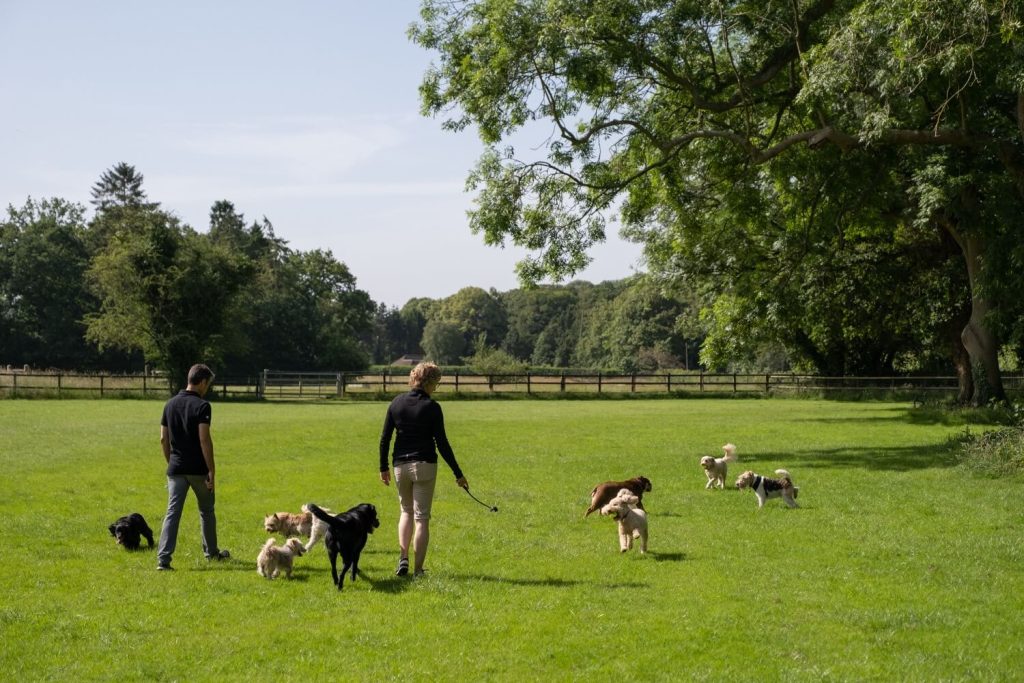Things to consider
Doggy Daycares are now highly regulated by the Government and are required to follow exacting guidelines and meet ever increasing standards of care – quite rightly – and so it’s a good idea to look for daycares that have been awarded the Five Star, Higher Standard rating which is the highest possible. Establishments also have a duty of care to all the visiting guests to ensure a safe environment not only for the dogs but also for the staff and the clients dropping off their dogs. Animals can be unpredictable, and all staff have to be trained to understand dog behaviour, recognise signs of stress or aggression, react accordingly and also be knowledgeable about the various natural characteristics of the different breeds.
A thorough onboarding process is essential, using a system like Kendal Shepherd’s Ladder of Communication to assess how new visitors are settling in and coping with being around strange people and other dogs is a great idea. As a result of the initial conversation with the daycare and then the subsequent trial day assessment you should get written feedback on your dog’s suitability for the establishment. Even if they don’t currently have a space that matches your dog’s needs, this doesn’t necessarily mean that your dog won’t fit into another daycare brilliantly, where perhaps a different mix of dogs and temperaments exist. The key thing is to approach the exercise with an open mind and with the aim of finding the establishment that is right for your dog. It’s easy to get upset if you’re not offered a place, but really this is not the right reaction as it means the daycare isn’t a good match for your individual needs. Move on, and try not to get emotional about it!

What does this mean in practice?
Well, usually it means grouping dogs according to their age, health, exercise needs, energy level, play ethic and temperament type. It’s not wise to group too many high energy dogs together as this can lead to high arousal and things “boiling over”. Therefore, sometimes there may be a limit on the number of dogs of a certain type that a daycare can take on, in order to maintain a suitable balance of temperaments, size, activity levels and exercise needs.
Dogs can behave differently at daycare than they do at home
Often owners are unaware that their dog may behave differently away from home in a group as he/she would either at home, or when out and about with their owner/family. This means that it can be the case that the daycare has to report back about undesirable behaviour that seems out of character to the owner. This may simply be that the dog is over excited/stimulated in a daycare situation, or that its natural instincts and breed-type behaviour show through much more in a group situation than at home with the family. Either way, it’s always important to take on the feedback calmly and work with the establishment to figure out what changes could be made to your dog’s day to enable him/her to cope better. It’s a dialogue that should be two-way and conducted in a calm and rational manner.
Which breed traits can present issues at daycare?
Some breeds have a high prey drive or a herding instinct. Often these behaviours can be controlled successfully at home or through going to training classes. However, in a daycare setting, herding instincts (for example often shown by Border Collies) might result in the dog wanting to round up its fellow playmates, giving them a nip or two along the way. That’s completely natural behaviour for the dog but it’s not something that daycare can easily cope with.
Are blanket bans on certain breeds acceptable?
Inevitably, due to some of the traits and behaviours already discussed, some establishments will decide that certain breeds don’t fit well within the groups that they have and the way they organise their exercise for the day. Staffies, Border Collies, Dobermans, German Shepherds, Rottweilers and some of the more exotic larger breeds are those that most often may not be accepted at some daycares. Again, owners need to see this from the point of view of what is best for their dog rather than from an emotional perspective or viewing it as an insult to the breed. No daycare sets out to offend any breed or client, but their experience over many years informs them about what works for them, and more importantly what doesn’t work in their particular daycare setting and owners are best advised to take the feedback in the constructive manner that it is intended.

So are smaller dogs always okay?
Not always! Some small breeds are prone to excessive barking, some Terriers are very high energy and refuse to be caught in!
The bottom line
A well run daycare will always be open about its breed policy and will discuss the possible issues with you in a constructive and open manner. Often, it takes several visits for a dog to settle so it’s never fair to make judgements on the impressions of the initial days. But the bottom line is that the decision of the daycare as to whether to accept an animal is always based on what is in the best interest of the dog and the other animals in the group and it should be taken as valuable input to help you find the right setting for you and your dog’s needs.
